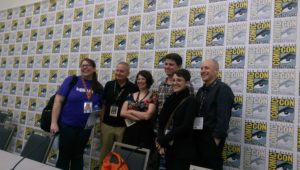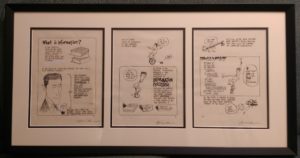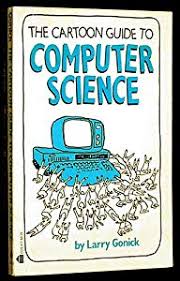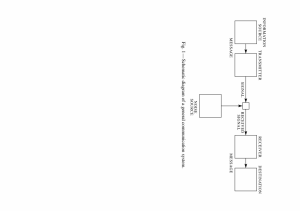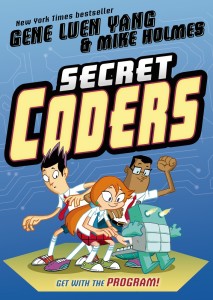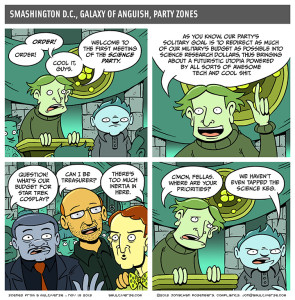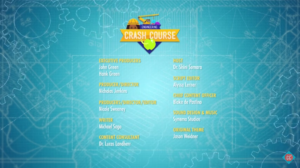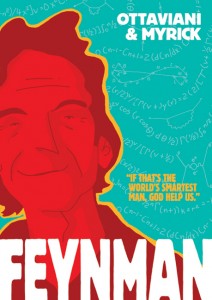Factual/Actual
[Editor’s note: Once again, there are relatively few direct quotes in these recaps, and those that exist are italicized. As a caveat to the reminder, the latter portion of this post comes from a conversation with Jim Ottaviani, but the paraphrase/quote rule remains in effect.]
That title up there makes me think about Frank Zappa’s Project/Object concept¹, which isn’t really tied into the work being discussed at the moment, but what else are you going to call a panel on making comics with factual bases about actual things? And a fine discussion it was, with Chula Vista librarian Judy Prince-Neeb wrangling Randall Munroe, Don Brown, Rachel Ignotofsky, Jim Ottaviani, and Dylan Meconis holding forth on how they get to the real.
But Gary, I hear you cry, Dylan Meconis works in fiction! True, Grasshopper, she does. But anybody that’s spent any time with her knows that she sweats the details to get a sense of place with the greatest verisimilitude known to humanity. She may have mucked up history into a Mirror Universe version of itself in Queen Of The Sea, but by God she got the goats right! We’ll come back to the goats in a minute.
The idea that factual doesn’t have to equal the truth, the whole truth, and nothing but the truth down to fourteen decimal places was a recurring theme. When asked by Prince-Neeb why they get excited by their work, Brown talked about the thrill of talking about Big Ideas and Moments (say, walking on the gosh-darned moon for the first time) and digging not into the BIaM itself, but the hundreds of thousands of much smaller bits and bobs that built up to it.
What Armstrong did in the roughly half-hour from start of the first lunar EVA until that one small step is exhaustively catalogued; what decisions were made between a design engineer and a lingerie seamstress to figure out how to make Armstrong’s suit? There’s room for interpretation there, a bit of impressionism that make the real moreseo².
For Ignotofsky, reality comes from the places where the hard data fears to tread. She’ll dig through a Census for fun, but when there’s little information committed to the historical record about the accomplishments of women, the indigenous, people of color, the LGTBQ+ community, focusing on those subjects for the benefit of kids means that future generations won’t have to rely as much on anecdotes when looking for people like them. The opportunity to see yourself as part of the world is what excites Ottaviani, that and the realization at a tender age that books are things that are made by people leading to the thought I could — should — make a book.
We’re living in History now is how Meconis puts it (you could hear the capital-H in her voice); the minutiae of our daily lives is future history and significant. How we lived our lives then shaped history. That minutiae lends a sense of reality to even the most fantastical world, making it all the more fascinating to the reader.
Munroe was, as may not surprise you, an outlier: I don’t know why I’m interested in anything, he said. Something catches his fancy, he works back to the science, engineering, and math, takes things to the logical extreme (he often ends up at some variation of Of course, now we’re at about 30% of the speed of light and have killed everybody on the East Coast), with the hope that it may accidentally cause a reader to learn something. Or, as Meconis put it, We’re big on tricking people!
So they all have some reason to share their work, but why pictures? Munroe’s decision is based on efficiency: you can see a big block of text and decide not to read it, but a picture on the page? You’ve already seen it; at least some part of it seeps through³. Ottaviani added that it’s pretty much impossible to stop reading in the middle of a comics page like you can in the middle of a paragraph; additionally, half of Science works from pictures already.
Sometimes, the motivation is elsewhere. Meconis notes that Writing + Drawing is like Juggling + Chainsaws; you can get attention if you’re good at either, but if you combine them, it’s a great way to get attention on the internet as a teenager! [Editor’s note: yikes.]
The bulk of the discussion was on research techniques. Munroe is relentless, digging down into the details of various commissions and committees that exist in the world, because that’s where the weird stuff (like how much water is legally required to pass over Niagara Falls, and how much of an act of war it is to alter it) lives. Ignotofsky haunts libraries and looks for the odd grace notes (like the famed painter in the early 1800s Paris how lived as an out lesbian, and was made to pay for a license to wear trousers; Munroe perked up and desperately wants to know if the office that issued that license issued others).
Meconis is fond of finding the one person that cares about a narrow subject more than anybody else, which is why she spent time on a Geocities site about heritage goat breeds maintained by dissident goat-breeders in remote Scotland. They have opinions on that newcomer Nubian goat, and arguments to back up those opinions. It might not make it to the Annals of the Royal Society, but it’s no less accurate. Plus, fiction! You can pick and choose where you want to be accurate.
Ottaviani is big on the personal interview, but has the advantage of mostly writing about people who are (or were recently) alive, and have/had friends/acquaintances who still are. He particularly noted that you can get a super accurate feel for a person without ever talking to them directly, citing the classic work of New Journalism by Gay Talese, Frank Sinatra Has A Cold (bonus: a pre-famous Harlan Ellison appears and almost gets his ass kicked). Add in a little visual reference (Ignotofsky: Get the photos! Get the clothing right! If you’re going to draw the dog, make you it’s the correct breed!) and you’re golden.
After the panel, I was lucky enough to sit down with Jim Ottaviani for a one-on-one discussion about his work, his artistic partnerships, and what’s next. His latest science bio, Hawking (art by the inimitable Leland Myrick, who also drew Feynman) released about two weeks before SDCC, and I thoroughly enjoyed it.
The first point of discussion was about the depiction of Jane, Hawking’s longtime wife, academic partner (when you can’t tie your own shoes, you certainly aren’t typing your own manuscripts), and primary caregiver. They divorced after Hawking became HAWKING, but remained on what I’d call unusually good terms for exes. Throughout the book, Jane is subtly, but progressively, depicted as … frustrated? annoyed? it’s tough to give a single word to the emotional heft in Myrick’s illustrations.
I read it as one part We’ve been married for more than two decades, why can’t you manage this one simple courtesy that’s annoyed me since before we were married and I’ve told you about it forever and MY GOD I hate you sometimes (everybody married more than a week has seen that look on their spouse’s face), one part You’re getting a bit full of yourself, Dr Hawking, and a few dozen parts absolute weariness at being a 24/7 caregiver, requiring ever-more challenging efforts, without so much as an afternoon off in who knows how long.
I think it’s an intimately truthful detail, to allow the great man to not be perfect, and ultimately sympathetic towards Jane, recognizing the tremendous sacrifices she made over decades. Ottaviani said the purpose was to show all of those emotional elements, with an addition of a growing distance between the couple — they had fundamentally incompatible belief systems4, exacerbated by his growing fame.
I read the entire later relationship between them as a classic case of being able to love somebody without liking them very much. He allowed that some of the friends of Jane Hawking were concerned about how she would be portrayed — it would be easy to cast her as a villain, abandoning her husband who is bravely clinging to life (not true, and Ottaviani and Myrick aren’t that lazy) — and concluded that he hoped his own friends would be as protective.
Ottaviani’s subjects, as our conversation hit on several times, could be complicated people. Richard Feynman is in a bit of a reappraisal, with people looking past the genius (especially for teaching) and seeing some really retrograde treatment of women for a big chunk of his life. He was also, to put it mildly, his own biggest cheerleader. His stories always make him look good, or smart, or funny, or popular, the center of attention. Hawking, by contrast, never tried to stick out (and I think even less so the more his ALS progressed), but found himself famous. Balancing that reticence with the obvious glee he exhibited while guesting on Star Trek or The Simpsons must have required a considerable effort (not to mention the fact that anybody with a measure of fame will attract cranks5).
My most burning question was who Ottaviani wants to cover next. He’s already hit the big name scientists and engineers that people might actually recognize (in addition to Feynman and Hawking, he’s covered Jane Goodall, Dian Fossey, and Biruteé Galdikas, Turing, Bohr, Oppenheimer and Szilard, and goodly bits of Einstein all throughout), so who next? I made a pitch for Claude Shannon6 (because you can never have enough Shannon), and he’s got some potential candidates in mind; it’s more than deciding that a scientist or engineer needs the Ottaviani treatment, it’s finding work that lends itself to visual representation and finding the right artist for the project.
In the meantime, he’s doing a series of two-pagers for the Royal Society Of Chemistry celebrating the Year Of The Periodic Table. Myrick’s got his own projects coming up, so it would be a while before they got to work again. I remarked how Myrick’s style provided a natural transition from depicting people to depicting scientific concepts and diagrams, and that led to a side discussion of art styles ranging from Mike Mignola to the Franco-Belgian ligne claire school. He’s not just writing for comics, he has a deep and abiding love of the form and the artists who make them. Asked who he’d like to work with, he replied Everybody I’ve already worked with, which is a pretty extensive list.
We finished out by making each other extremely envious of the other’s original comic art collection. Ottaviani has several Richard Thompson originals, including one of God bouncing dice off Einstein’s head. I have several Larry Gonick original pages featuring Shannon. In the end, it was a really pleasant conversation between a couple of engineers, talkin’ about comics and fountain pens, the sort that leaves you wrapped up until you have to walk briskly to your next appointment. If you ever have the chance to do the same, I recommend it.
Spam of the day:
We are currently recruiting companies/individuals on behalf of our company located in china {Beauty Forth Garment & Accessories Co., Ltd (BFGA)} for a number of account receivable agents in USA/CANADA.
This position does not affect your current job or business operations.
I am sore tempted to find out just how much this position does not affect my current job.
_______________
¹ Key takeaway, and I quote:
In the case of the Project/Object, you may find a little poodle over here, a little blow job over there, etc., etc. I am not obsessed by poodles or blow jobs, however; these words (and others of equal insignificance), along with pictorial images and melodic themes, recur throughout the albums, interviews, films, videos (and this book) for no other reason than to unify the ‘collection.’
² Cf: Kazu Kibuishi’s abstract landscapes, which look more real to us the less detail he adds.
³ Meconis noted the downside: parents can more easily find something to be offended by in a picture than by reading things line by line. This point would be echoed in a couple of the teacher/librarian panels over the course of the Con.
4 Jane being rather more a Christian than Stephen, and he being frankly rude as shit in his dismissal of her beliefs.
5 I’ve actually met one of Hawking’s cranks and the dude struck me as somebody I should slowly back away from, making no sudden moves. I can’t imagine what dealing with him must be like in a severely limited body.
6 Let the record show that he recognized Figure 1 on the cover of my notebook.
